Optimising sorghum genetics and management for targeted situations
Author: David Jordan & Daniel Rodriguez, QAAFI | Date: 21 Jun 2016
Take home message
- Yield in sorghum is not just agronomy or hybrid choice, what really matters is to understand how to match hybrids and management to sites and expected seasonal conditions.
- Substantial opportunities exist to increase productivity by providing growers access to hybrids with a wider range of trait characteristics.
How are improvements in crop productivity achieved?
Historically productivity gains in cereals have come from changes in improved agronomy and varieties. The biggest increases in productivity have come from the interaction between changes in genotype and management that target particular environments, often described as GxExM or specific adaptation. These GxExM advances have often come from trial and error rather than specific research specifically designed to identify good combinations. Advances in our understanding of factors influencing crop yield mean that we are now in a better position to identify new and better match existing agronomy and variety to deliver higher yields.
Specific adaptation
Plant breeders typically use one of two strategies for developing new hybrids, either they select for broadly adapted hybrids that work well on average across environments but may sacrifice yield in particularly good or poor environments; or, they select for specifically adapted hybrids to perform well in particular environments but have poor average performance.
Australia’s variable climate and sorghum growing environments offer the opportunity to design the crop (GxM) that best matches the site, as well as prevailing and expected seasonal conditions. This is, water availability driven by starting soil moisture and nitrogen, soil water holding capacity, and expected in crop rainfall and temperature.
This requires managing the balance between designing the crop to achieve maximum yield by using as much of the available water as possible, and the risk of substantial yield reductions and lodging caused if water stress occurs during grain filling.
Adaptation to particular environments can be achieved by designing the crop matching the hybrids, this is maturity and canopy sizes (mainly tillering); and by modifying management, population, nitrogen supply and row spacing.
Australian sorghum breeders have tended to develop hybrids with broad adaption because of our small seed market and highly variable environments. Growers can achieve some specific adaptation to their situations by management changes such as planting time population, nitrogen supply and row spacing to adapt sorghum to their environments. Despite this focus on broad adaption, some varietal differences exist that provide opportunities to maximize performance by optimizing management for existing varieties grown in specific situations as well as determining if there are opportunities to breed for specific adaptation.
GRDC is funding research in both areas, project UQ00075 is producing sorghum hybrid type and agro-ecology specific recommendations in the Northern Region that are helping growers match commercially available varieties to environments and seasonal conditions. GRDC project UQ00070 is focused on the development of sorghum breeding lines incorporating variation in traits predicted to improve productivity in the northern region combination with particular managements. Both projects are being led by the Queensland Alliance for Agriculture and Food Innovation (QAAFI) at the University of Queensland, in collaboration with the Queensland Department of Agriculture and Fisheries, grower groups, agribusinesses and seed companies.
What opportunities exist with current hybrids?
We conducted on farm research trials at 19 locations across Queensland investigating the performance of twelve commercial and experimental hybrids representing the major types available, with variations in density and row spacing. More than 2000 plots were planted between 2014 and 2016. Hybrid types were defined by the maturity and tillering characteristics of the hybrids. Maturity in the hybrids varied from 55 to 62 days to flowering; and from 106 to 113 days to maturity. High and low tillering hybrids produced 3.5 and 2.5 tillers per plant (at flowering); though both types produced around 2.1 heads per plant at maturity.
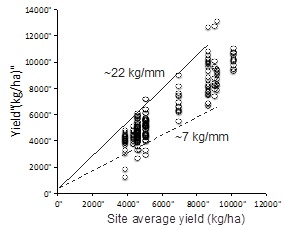
Figure 1. Example of a performance graph representing the yield of different hybrids across a number of sites having different yield potential.
To understand what combination of hybrids and managements perform best across the different sites, results are being analysed by comparing the performance of each treatment at each site as a function of the average yield of each site i.e. an indication of the yield potential at each site (Fig 1). Figure 1 presents the data for 2.14/15, and shows that at each site (columns of points) some treatments yielded twice as much as others. Comparing the best and worst yields at each site showed a 3-fold increase in water use efficiency i.e. from 7 to 22 kg/mm/ha. Figure 1 indicates that understanding what treatments are the top performers across the range of tested sites, can give us an idea of what combination of hybrids and management maximised yields for sites that in average yielded between 4 and 11t/ha.
When the different hybrid traits were dissected we found that the longer cycles tended to yield more in the better environments i.e. higher environmental index (left panel in Figure 2. We also observed that that newly released hybrids tended to perform better than MR Buster in the poorer environments, though similarly in the better environments (Figure 2 right panel). This is probably associated with the effort by breeding programs to develop drought tolerant hybrids. Figure 3 shows that solid configurations outperformed single skip configurations, though it is important to note that none of these trials experienced dry conditions during the 2014/15 season. Figure 3 (right panel) also shows that more recently released hybrids performed better than MR Buster in single skip configurations.

Figure 2. Sorghum yields as a function of the environmental index grouped by maturity type (left panel), and treatments yield relative to the yield of MR Buster (hybrid check) (right panel).

Figure 3. Sorghum yields as a function of the environmental index grouped by configuration (left panel), and treatments yield relative to the yield of MR Buster (hybrid check) (right panel).
Figure 4 below shows that tillering type did not influence the final yield across the tested environments, though it is again important to note that at the sites we had these trials we didn’t had dry conditions. Low tillering hybrids would have been expected to perform better under dryer conditions. It was interesting to observe the high compensation capacity of sorghum when planted at contrasting plant densities (Figure 5). At low densities i.e. below 50,000 plants / ha, more than half of the yield was produced on tiller panicles, while above 70,000 plants / ha most of the yield was produced on main stem panicles.
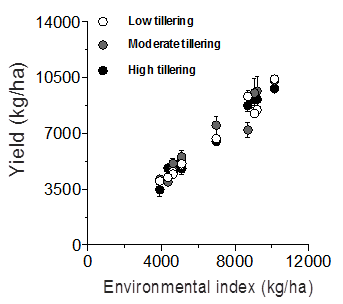
Figure 4. Sorghum yields as a function of the environmental index grouped by tillering type.
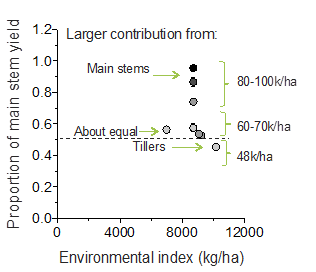
Figure 5. Sorghum yields as a function of the environmental index grouped by plant density relative to the yield of the hybrid check (MR Buster).
Future hybrids
The sorghum pre-breeding program currently GRDC project UQ00070 has been delivering traits to growers through the private seed industry since the1960s. The program produces new screening methods and breeding lines that are licensed to the commercial seed industry with 100% of current commercial hybrids containing genetics from the program. Commercial licensing started in 1989 since that time more than 2400 lines have been licensed and currently 85% of commercial hybrids generating royalties for core breeding program which are reinvested into sorghum research. Licensed lines are either used directly as hybrid parents or indirectly by crossing licensed lines to commercial material to produce new parents within the company’s breeding program.
A major focus of the current pre-breeding activity is to develop germplasm with adaptation to Australian environments that have useful variation in key traits associated with water capture and adaptation. These variations include: maturity, tillering potential, transpiration efficiency, plant height and root architecture, high temperature tolerance and grain fill duration
Tiller number
Sorghum plants react to space and water availability to producing tillers. Tillering is favoured by conditions of high light intensity and lower temperatures as occurs in early planted crops. Tillering can compensate for poor establishment but it also limits the control that growers have over crop water use as tillering reduces the impact of reducing in plant population on water use. Prolific tillering early in the season may lead to excessive leaf area and the onset of drought later in the season. Potentially varieties with low or no tillers could provide advantages to growers trying to optimize water use. Current varieties have relatively low variation in tillering potential. Figure 6 below shows the variation in tillering potential available in experimental hybrids grown in 7 sites from northern NSW to Central Queensland. Site yields ranged from 3-7 tonnes per ha. Analysis of these trials indicated no negative effects on yield or lodging of low tillering, showing the potential feasibility of low tillering hybrids.
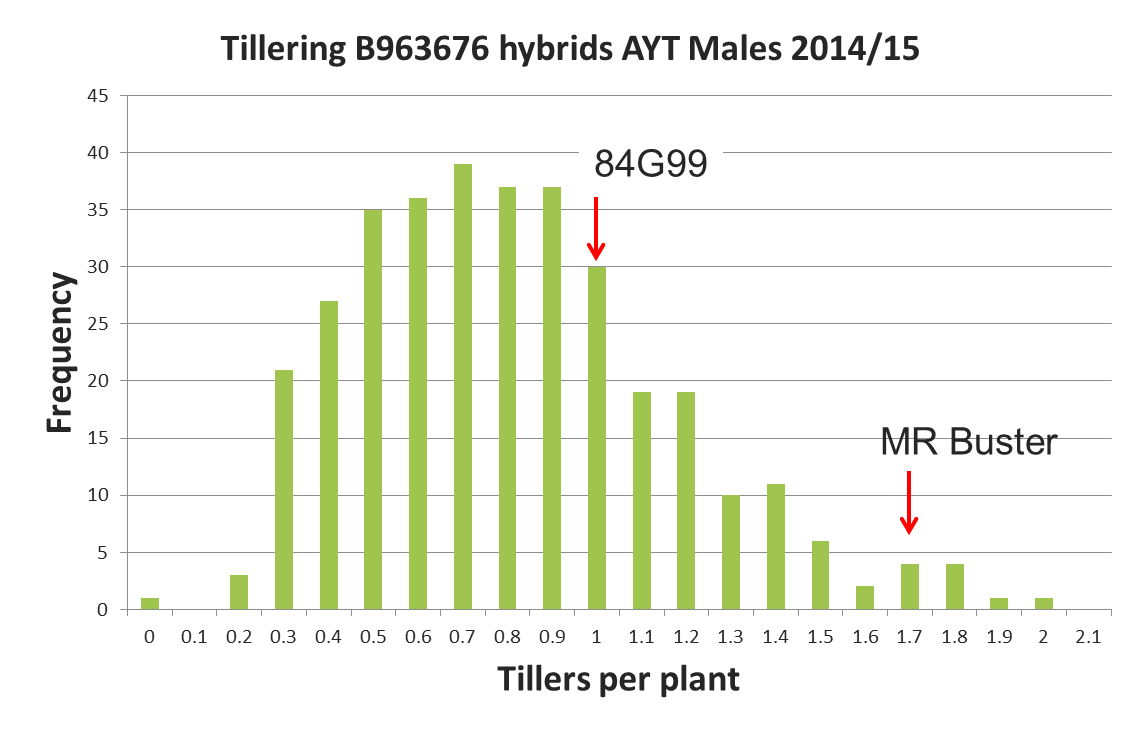
Figure 6. Tillering potential in experimental hybrids compared to high and low tillering commercial hybrids
Root angle
Sorghum plants vary in seedling nodal root angle (Figure 7), which in turn has been shown to influences the timing and water extraction patterns of mature plants. Plants with narrow angle tend to extract more water at depth while plants with narrow root angles extract more water in the inter-row. Varieties with narrow root angle are likely to have advantages when grown in solid row configurations or in soils where water is available at depth. Wide angle genotypes, on the contrary, may be more suited to shallower soils where wide row spacing is used.
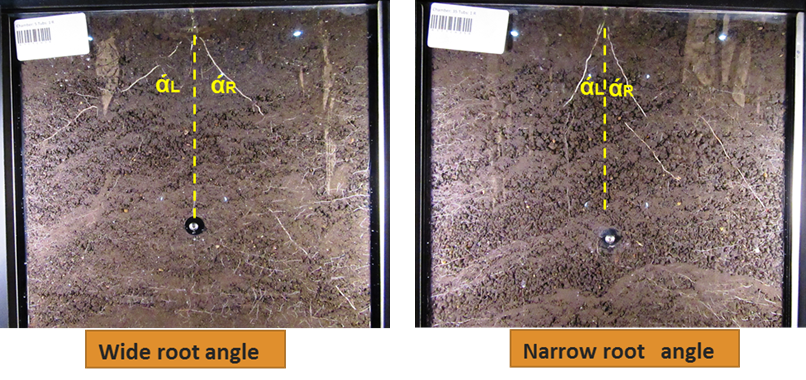
Figure 7. Variation in nodal root angle in sorghum seedlings
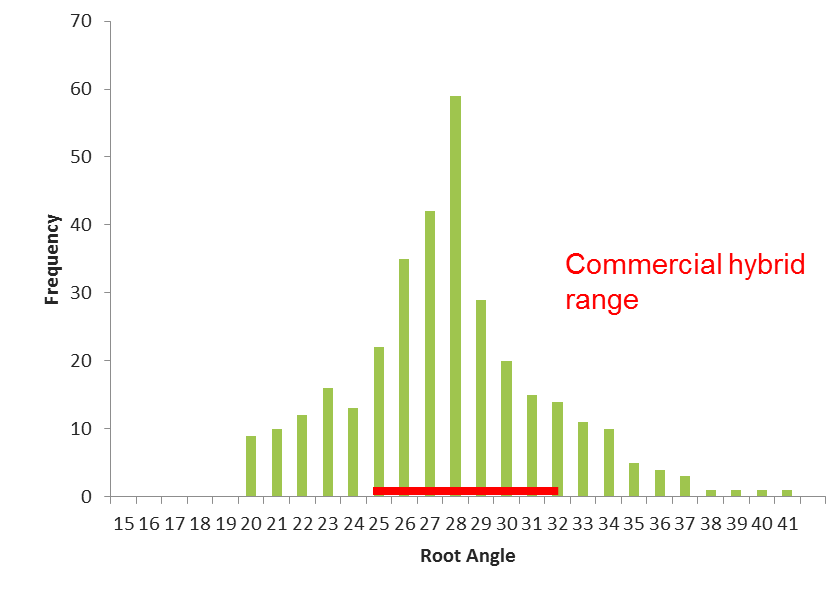
Figure 8. Root angle of 333 experimental hybrids compared with the commercial range
Data from recent screening of commercial and experimental hybrids (figure 8) indicates that variation in root angle of commercial hybrids is limited (25-32 degrees) while substantially more variation is available in experimental materials (20-40 degrees). This result indicates opportunities to develop hybrids with specific adaptation to the deep soils of the higher yielding regions of the Liverpool plains and Darling Downs; and hybrids designed to perform better in wider or skip row configurations in the more marginal environments of the Western Downs and Central Queensland.
Conclusions
- Results from our first season of agronomy trials showed almost a two-fold increase in yield that could be achieved by better matching agronomy to hybrid type across the tested sites. These findings question the idea that agronomy outweighs genetics in sorghum yield; and emphasises that what really matters is to understand how to match hybrids and management to sites and expected seasonal conditions.
- For the high yielding environments the highest yields were obtained with higher tillering and later maturity hybrids planted in solid configurations at medium to high plant populations.
- In the medium yielding environments, highest yields were obtained with medium tillering and medium maturity hybrids planted in solid configurations at medium to high plant populations.
- In the low yielding environments, highest yields were obtained with low tillering and earlier maturity hybrids planted in solid configurations at low plant populations.
- Considerable genetic potential exists to develop hybrids with specific characteristics that when combined with management would enhance crop yield in particular types of sorghum environments
Acknowledgements
The research undertaken as part of this project is made possible by the significant contributions of growers through both trial cooperation and the support of the GRDC, the authors would like to thank them for their continued support.
The authors also acknowledge support from the Bill and Melinda Gates foundation and the Australian Research Council.
Contact details
David Jordan
Queensland Alliance for Agriculture and Food Innovation (QAAFI)
Hermitage research station Warwick
Ph: 07 46603622
Fx: 07 4660 3600
Email: David.Jordan@uq.edu.au
Daniel Rodriguez
Queensland Alliance for Agriculture and Food Innovation (QAAFI)
203 Tor Street Toowoomba Qld 4350
Ph: 07 46881437
M: 0434075094
Email: d.rodriguez@uq.edu.au
Was this page helpful?
YOUR FEEDBACK
